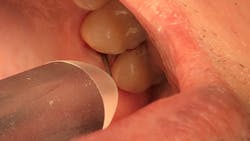Which dental laser should you choose, and what can you use it for?
Which procedures can you perform with a dental laser? That depends on which laser you’re using. There are a variety of lasers to choose from; once you determine their uses, you can decide which one is best suited for your practice. Types of lasers include Er:YAG and Er:CrYSGG, diodes, Nd:YAG, and CO₂. Each laser has unique characteristics, and several manufacturers specialize in each type.
So, you want to be a laser dental hygienist?
How hygienists can use dental lasers for infection control during the pandemic and beyond
Er:YAG and Er:CrYSGG lasers
These are hard-tissue lasers that are attracted to water and hydroxyapatite. Dentists primarily use these lasers due to their attraction to tooth surfaces and higher costs to purchase and maintain. You can use these lasers to perform just about any procedure that can be done with traditional instruments, such as bone recontouring, prepping teeth for fillings or crowns, hard-tissue crown lengthening, and exposure of teeth under bone. One example of this type of laser is the Biolase Waterlase laser.1
Diode lasers
The most economic dental lasers are diode lasers. These are soft-tissue lasers that doctors often purchase as their first laser, occasionally passing them on to their hygiene team. Because diode lasers are economical and easy to use, they are the ones used most commonly by dental hygienists to perform the procedures listed above. Diode lasers are portable, easily moved from operatory to operatory, and deliver very competent results. A few of the diode lasers that are used in hygiene and dental procedures are the Ultradent Gemini and Evo lasers, AMD/CAO, King Dental Beamer, and the Biolase Epic Hygiene laser.2-4
Nd:YAG lasers
These lasers have been used in dental practices since the early 1990s. They were one of the first lasers clinicians used until diodes became available. Nd:YAG lasers are primarily soft-tissue lasers that can be used for many of the same procedures as diode lasers. They are a little pricier than diodes and a bit bigger in size, but both hygiene and dental professionals still use these lasers today.5
CO2 lasers
As a laser educator, several hygienists have asked me about CO₂ lasers. I am a big proponent of them. They are highly absorbed in tissue due to the interaction of water, and they’re superior at cutting soft tissue without bleeding. Two very popular CO₂ lasers are DEKA and DENTA RF (GPT Dental), which continue to impress hygienists and their patients with optimal results. Newer lasers provide even more options for dental hygienists and greatly improve the patient experience.6,7
Another CO₂ laser is the Solea laser (Convergent Dental). Although CO2 lasers are primarily used for soft-tissue procedures, Solea is unique in that it is the first CO2 laser system cleared by the FDA for both hard- and soft-tissue procedures in dentistry. This laser also offers numerous advantages to the dental practice.8
Why you should consult your State Dental Practice Act
Whichever laser you use, make sure you know exactly what you, as a hygienist, can do legally with your laser. Begin by becoming familiar with your State Dental Practice Act. It is your responsibility to read the regulations to determine if you can use your laser in the state where you reside as well as make sure that the procedures you set out to do can be legally completed by a dental hygienist.
If these rules change—which they are known to do from time to time—you must keep up with the changes. Remember, if you are not able to do these procedures without a laser, then you will not be able to legally complete them even if you have a laser. For example, if hygienists in your state cannot perform a gingivectomy, then they can’t perform one with a laser either.
Training and certification in lasers
Once you understand what laser you will be using and what that laser is capable of clinically, your State Dental Practice Act will tell you whether you’ll require training or a certification course. The class should encompass at least eight hours of tutorial and four hours of hands-on training to build competency and proficiency. Most states require only basic knowledge, but as lasers continue to evolve, it is highly recommended that you take all the laser classes you can to educate yourself on the evolving techniques and applications for your laser. There is no such thing as too much laser training; every educator can provide you with skills that can be beneficial as you strive to be the best laser dental hygienist you can be.
Many laser manufacturers also have training and/or videos to help you. However, most of this training is just enough to get you started. Additional training is highly recommended and will include a more detailed training or certification to perfect your techniques and safely incorporate your laser into practice.9
Coding for laser procedures
Once you start integrating lasers into your clinical armamentarium, you can use the dental codes that have already been established; in other words, there are no “extra” codes for lasers and dental hygiene procedures. Fees are adjusted appropriately for each code. Be careful: insurance policies will clarify whether you can charge patients for out-of-pocket expenses or if you’ll need to write them off. Many insurance companies are starting to look into this more closely, so make sure you follow the rules in your contract with the company.
I hope I’ve sparked an interest in you for lasers in dentistry. Please contact me with any additional questions about the role lasers can play in your dental practice.
Editor’s note: This article first appeared in Through the Loupes newsletter, a publication of the Endeavor Business Media Dental Group. Read more articles and subscribe to Through the Loupes.
References
- Biolase. https://www.biolase.com/
- Gemini Laser. Ultradent Products. https://www.ultradent.com/products/categories/equipment/diode-lasers/gemini-laser
- Beamer Laser. King Dental Company. https://www.beamerstl980.com/
- AMD Lasers. https://www.amdlasers.com/
- Fotona Lasers. https://www.fotona.com
- DEKA Dental Lasers. https://dekadentallasers.com/
- Dental CO2 Lasers. GPT Dental. https://www.gptdental.com/co2-dental-lasers
- Solea All-Tissue Laser. Convergent Dental. https://www.convergentdental.com
- Academy of Laser Dentistry. https://www.laserdentistry.org/
About the Author
Angie Wallace, RDH
Angie Wallace, RDH, has been a clinical hygienist for more than 35 years. She is a member of the Academy of Laser Dentistry (ALD), where she obtained her advanced level proficiency, educator status, Recognized Course Provider status, and mastership. Angie is the chair for education on the ALD Board of Directors and serves on both the Regulatory Affairs and Auxiliary committees. She has a laser education consulting company, Laser Hygiene, LLC, and has been recognized as a worldwide speaker. Contact her at [email protected].

